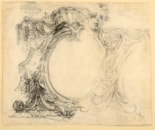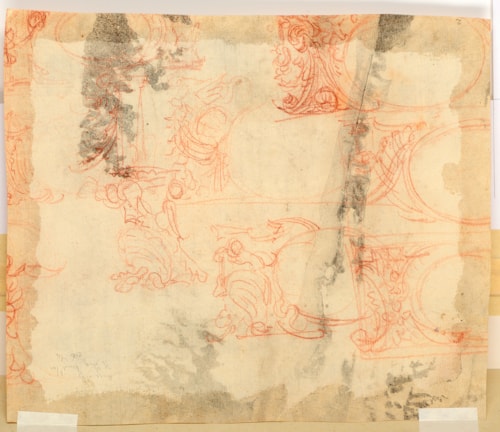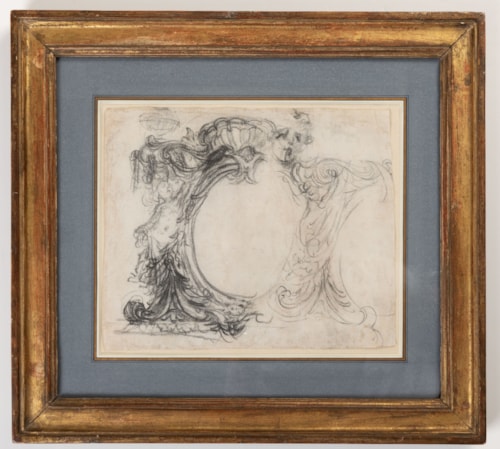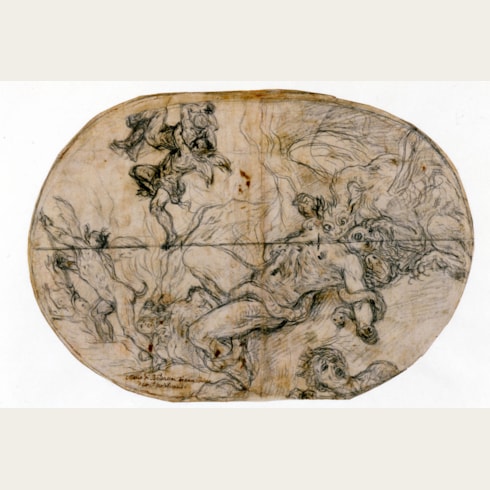Baldassare Franceschini VOLTERRANO
(Volterra 1611 - Florence 1690)
Study of Two Variant Designs for a Cartouche [recto]; Studies of Frames or Cartouches [verso]
Black chalk.
The verso in red chalk.
247 x 260 mm. (9 3/4 x 10 1/4 in.)
The verso in red chalk.
247 x 260 mm. (9 3/4 x 10 1/4 in.)
Although he was a prolific draughtsman, drawings for architecture, decorative motifs and metalwork by Volterrano are relatively rare. A group of twenty-four drawings of this type are in the Kunstbibliothek in Berlin, while several others were included among a large group of drawings by the artist sold at auction in 1980. As McCorquodale has pointed out, ‘Volterrano...allowed his most robust, if controlled, drawing style to emerge in his designs for carving, stuccoes, metalwork and other decoration’, while another scholar has noted that such drawings display ‘the elegance and sophistication [that are] always present in Volterrano’s decorations.’
As has also been noted of such works, ‘The florid baroque style evident in these drawings, and even the way numerous unfinished sketches are crowded on to the sheet, seem to be inspired by Bernini, whose work Volterrano knew from his two stays in Rome, but the condensed nature of the ornament is characteristically Florentine.’ Volterrano is known to have designed a handful of picture frames; a painting of The Baptism of Christ by Paolo Veronese in the collection of the Grand Duke Ferdinando II de’ Medici, for example, is set into an elaborate gilt frame carved by Jacopo Maria Foggini to a design by Volterrano. Other drawings for frames by Volterrano are in the collections of the Rijksmuseum in Amsterdam, the Kunstbibliothek in Berlin, the Library of the Romanian Academy in Bucharest and the Metropolitan Museum of Art in New York.
The present sheet may be compared to other drawings by Volterrano for decorative details and ornament, such as two sheets of studies for the design of a frame, sold alongside the present drawing at auction in London in 1980, and several of the drawings in the Kunstbibliothek in Berlin. The verso of the present sheet, drawn in red chalk, appears to show several designs for frames or cartouches, and may be compared with a drawing for an oval cartouche or frame which was on the art market in London in 2004 and is now in the collection of the National Gallery of Scotland in Edinburgh.
As has also been noted of such works, ‘The florid baroque style evident in these drawings, and even the way numerous unfinished sketches are crowded on to the sheet, seem to be inspired by Bernini, whose work Volterrano knew from his two stays in Rome, but the condensed nature of the ornament is characteristically Florentine.’ Volterrano is known to have designed a handful of picture frames; a painting of The Baptism of Christ by Paolo Veronese in the collection of the Grand Duke Ferdinando II de’ Medici, for example, is set into an elaborate gilt frame carved by Jacopo Maria Foggini to a design by Volterrano. Other drawings for frames by Volterrano are in the collections of the Rijksmuseum in Amsterdam, the Kunstbibliothek in Berlin, the Library of the Romanian Academy in Bucharest and the Metropolitan Museum of Art in New York.
The present sheet may be compared to other drawings by Volterrano for decorative details and ornament, such as two sheets of studies for the design of a frame, sold alongside the present drawing at auction in London in 1980, and several of the drawings in the Kunstbibliothek in Berlin. The verso of the present sheet, drawn in red chalk, appears to show several designs for frames or cartouches, and may be compared with a drawing for an oval cartouche or frame which was on the art market in London in 2004 and is now in the collection of the National Gallery of Scotland in Edinburgh.
The preeminent fresco painter in Florence in the latter half of the 17th century, Baldassare Franceschini, known as Il Volterrano after his birthplace, studied with Matteo Rosselli and Giovanni da San Giovanni. His first significant independent commission came in 1636, when he was entrusted by Prince Don Lorenzo de’ Medici with the fresco decoration of the courtyard of the Medici villa of La Petraia, near Florence. This cycle of scenes from Medici history was not completed for another twelve years, however, as other commissions interrupted the project.
Volterrano painted frescoes, altarpieces and easel pictures for numerous churches and palaces in Florence, Volterra and Rome. His large-scale, crowded fresco compositions reflect an adaptation into a Florentine idiom of the Roman Baroque manner, derived from Pietro da Cortona’s frescoes in the Palazzo Pitti, where Volterrano himself also worked, decorating the ceiling of the Sala di Vittoria della Rovere. His painting style also shows the influence of Correggio, whose work in Parma he studied extensively; indeed one of Volterrano’s biographers, Niccolò Gabburri, describes the artist as ‘il secondo Correggio o pure il Coreggio dei Fiorentini.’
In 1650 Volterrano painted a large fresco of The Angels Ministering to Christ in the Wilderness for the refectory of the Florentine convent of Santa Teresa, a work he considered to be one of his finest achievements. Some of the artist’s most significant commissions were for Santissima Annunziata in Florence, where his fresco decoration of the chapel of Sant’Ansano in 1643 began an association with the church that was to last almost to the end of his career. Between 1664 and 1683, Volterrano executed paintings for the ceiling of the nave of the church and an altarpiece of San Filippo Benizzi in Glory, and his work at Santissima Annunziata culminated in the cupola fresco of The Coronation of the Virgin. Commissioned by the Grand Duke Cosimo III, the fresco was the artist’s last major project, as he suffered a stroke shortly after its completion.
Undoubtedly one of the finest draughtsmen of the Florentine Seicento, Volterrano, as one modern scholar has noted, ‘can take his place alongside the other major draughtsmen of the Baroque era; there is nothing provincial about any aspect of his drawing.’ Both of the artist’s biographers, Filippo Baldinucci and Francesco Maria Niccolò Gabburri, owned several of his drawings, and they were also popular with collectors. The largest extant groups of drawings by Volterrano are today in the collections of the Uffizi and the Albertina, while a number of designs for architecture, decorative motifs and metalwork are in the Kunstbibliothek in Berlin.
Provenance
Probably part of a group of 410 drawings by Volterrano, mounted into four albums, sold Paris, Hôtel Drouot, 8 November 1922, lot 214
Anonymous sale (‘An Important Group of Drawings by Baldassare Franceschini, called Il Volterrano’), London, Sotheby’s, 3 July 1980, lot 2 (‘An ornamental frame, and a study of a face. Black chalk. 215 x 252. On the verso are red chalk studies of decorative carving.’)
Brian Sewell, London.
Anonymous sale (‘An Important Group of Drawings by Baldassare Franceschini, called Il Volterrano’), London, Sotheby’s, 3 July 1980, lot 2 (‘An ornamental frame, and a study of a face. Black chalk. 215 x 252. On the verso are red chalk studies of decorative carving.’)
Brian Sewell, London.







